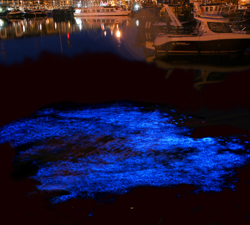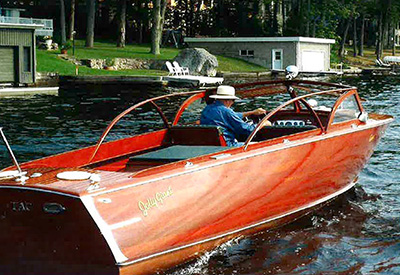A Sparkling Sea

By Audrey Wilson
Whether you see it as fairy dust in the water or stars in the head, ocean bioluminescence is a fascinating phenomenon.
I had my most recent exposure to the remarkable phenomenon called bioluminescence during our beautiful West Coast weather last autumn. It was a crisp, clear night and we were on a mooring buoy at Newcastle Island Marine Park in Nanaimo, when my husband spoke to my love of the night sky and offered to take me for a dinghy ride to see the stars.
We wove our way through the channel between Newcastle and Protection islands to get away from the city and island lights. We made the dinghy comfortable with our portable captain’s chairs, and our small electric motor allowed us a noiseless passage at a relaxed pace. Before lying back and settling in to star gaze, I glanced forward past the bow into the black water and was amazed by another spectacular flashing display of light. This starry show was not in the sky but in the water!
Earlier that day I had noticed a very heavy coating of plankton on the surface of the water but I thought no further about it. At night, the ramifications of that heavy layer were like thousands of tiny, squirming stars in a sea of black! As the dinghy pushed through the water, it produced an explosion of dancing, squiggling light. Doing gentle “donuts,” we created a thin stream of fairy dust that swirled around us, interspersed with remarkably large pieces of bioluminescence the size of snowflakes.
 I was aware of the phenomenon of bioluminescence through watching documentaries on television and through an excellent display at the Royal BC Museum in Victoria. However, I had never really taken the time to look at it closely. My glimpse last fall made me curious to understand it more fully.
I was aware of the phenomenon of bioluminescence through watching documentaries on television and through an excellent display at the Royal BC Museum in Victoria. However, I had never really taken the time to look at it closely. My glimpse last fall made me curious to understand it more fully.
Upon our return home, I began to research bioluminescence. I spoke with Dr. Dennis Thoney, director of animal operations at the Vancouver Aquarium, and he described bioluminescence briefly as “…light produced by animals by an exothermic chemical reaction that produces energy released as light.” He explained that the group of chemicals that make plankton glow are broadly termed luciferins, and the light is produced by a series of oxidation reactions set off by a catalyst called luciferase. Bioluminescence is a form of “cold light” or luminescence.
Interestingly, fish have bioluminescence which occurs in specific spots on their bodies in relation to their specific function. Fish light up in order to disappear, attract a species-specific mate, or even to defend against a predator, producing a short flash to attract another predator to the creature threatening it. In tropical waters, fish may have a little external ray or “fishing pole” that they can use as a lure for prey.
Brilliant Plankton
 A vast range of plankton – both zooplankton and single-celled animal plankton – is known to be bioluminescent and occur in all the world’s oceans. The most common of these are dinoflagellates, tiny unicellular marine plankton. In contrast to fish, their bioluminescence glow fuses fully through the animal; it is usually used to escape but only lasts for a few seconds because it takes a lot of energy to produce the light.
A vast range of plankton – both zooplankton and single-celled animal plankton – is known to be bioluminescent and occur in all the world’s oceans. The most common of these are dinoflagellates, tiny unicellular marine plankton. In contrast to fish, their bioluminescence glow fuses fully through the animal; it is usually used to escape but only lasts for a few seconds because it takes a lot of energy to produce the light.
According to Dr. Thoney, the western coasts of the world’s continents are richer in bioluminescent plankton due to greater upwelling. Winds blow from the west across the oceans, pushing surface water away so that more water rises up from beneath the surface to replace it. Sub-surface water is typically colder and richer in nutrients. These nutrients fertilize the surface waters, meaning that they often have high biological productivity. The heaviest concentration of surface life will be in the spring and late summer. Indeed, a “red tide” or plankton bloom such as I saw is rich in dinoflagellates, causing a spectacular nighttime show of bioluminescence.
This phenomenon never fails to delight the uninitiated, no matter how unconventional your first viewing is. My first glimpse of this wonder was one night while using the head! I had left the light off so as not to bother my sleeping husband, used the facilities and then, while flushing, saw an explosion of “sparklies” swirling in the bowl! My peals of giggles woke Calvin and I shared my discovery with him.
If you have never experienced bioluminescence, you may get your first glimpse of “sparklies in the head.” You could try a more conventional method and take a dinghy ride by night. You might even try a night swim or dive in search of more opportunities to see a diverse selection of animals that “light up.” However you do it, remember to stir or disturb those dinoflagellates, then sit back and watch the show!
Audrey Wilson’s first boating experience was living aboard as a child with her parents in the late’60s. She and husband Calvin bought their US Yachts 27 sailboat in 2011 and are discovering, by trial and error, the joys of sailing around Nanaimo and the Gulf Islands.
PHOTO CAPTIONS
Photo 1 – Light shows of bioluminescence in coastal waters are produced by plankton known as dinoflagellates.
Photo 2 & 3 – West Coast dinoflagellates include Ceratium furca (2) andNoctiluca scintillans or “sea sparkle”.





























